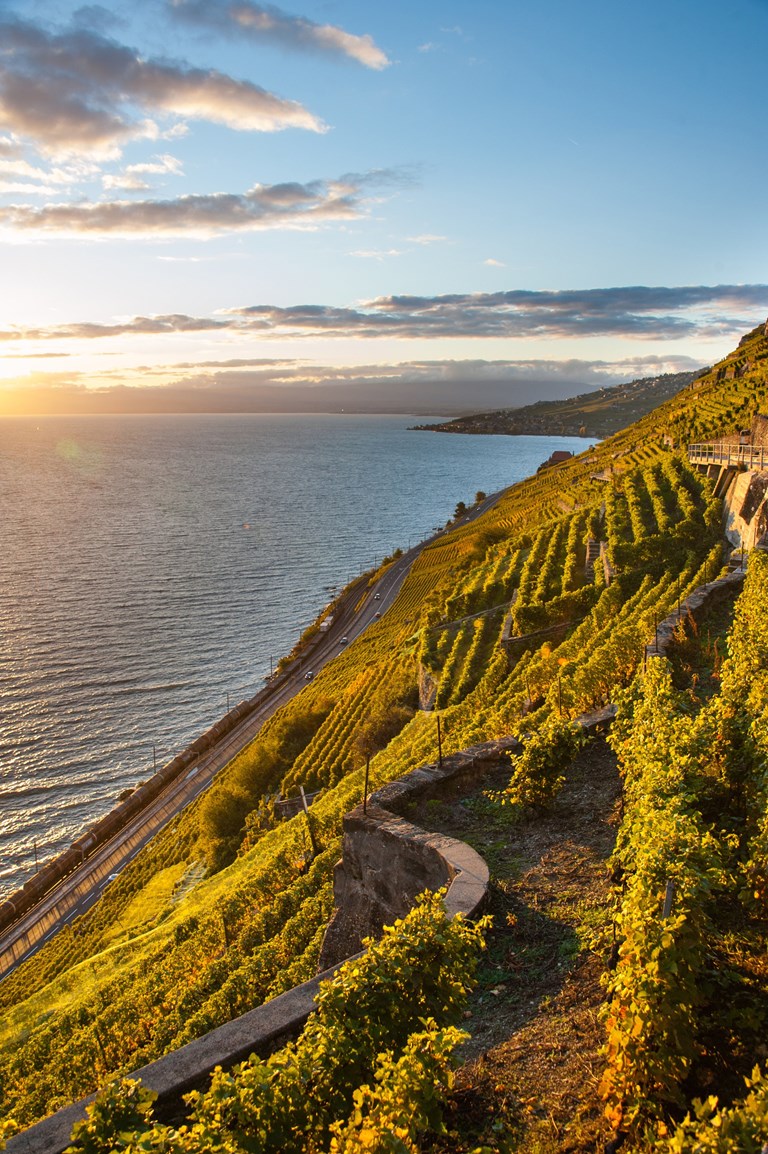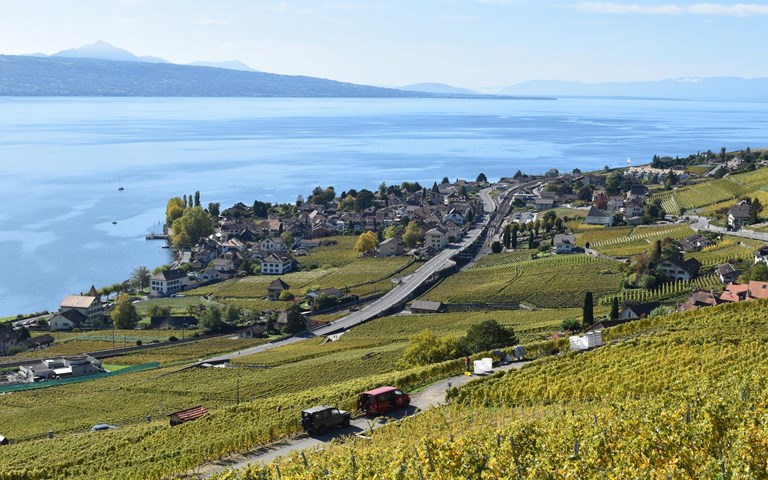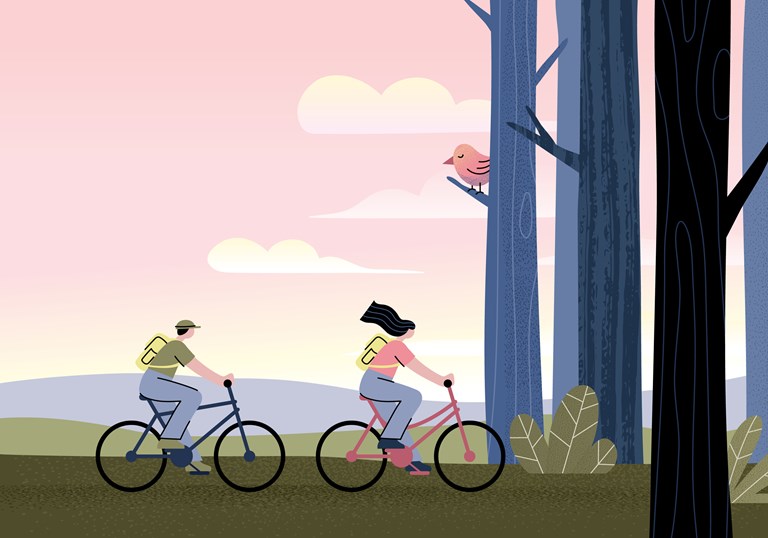
Symphony of wines in conservatory
The wine of the future has ancient origins.
To fully understand what this phrase means, it is necessary to go to the conservatory, not the musical one, but the one created thanks to Louis-Philippe Bovard in the upper part of the village of Rivaz, overlooking the banks of Lake Geneva.
It is the Chasselas World Conservatory. Chasselas is a vine that has been present for over two millennia in the lake’s basin, giving rise to numerous varieties. In the plot of 4,500 square meters, made available by the Domaine Louis Bovard, are gathered 19 historic varieties of the vine, but it has been worked mainly on the five that were once more widespread in the Vaud: Fendant roux, Vert de la Côte, Blanchette, Giclet and Bois rouge.
The last two turned out to be the most interesting. They seem to adapt better to climate change. The wine of the future is therefore born from the rediscovery of the old vines. In an area that is UNESCO World Heritage Site, the Bovards have been taking care of those vines planted on the scenic terraces that look like a staircase that disappears in the waters of the lake for ten generations.
They select the grapes, parcel by parcel, in order to obtain wines of a great quality. Fabio Bongulielmi, director of Domaine Louis Bovard, tells us.
At 44, he has a master’s degree in musicology, has organised cultural events in Germany, worked for five years at the Swiss General Consulate in New York and worked for over seven years for a large electricity infrastructure company. He has already lived three lives, but his passion drives him to get back into the game. So, 4 years ago, Fabio Bongulielmi attended a programme at the Hotel School of Lausanne in order to devote himself to the world of wine. At the end of his studies, he found an advertisement in an agency looking for a sales manager, the sector was not specified; he answered. They asked him if he liked wine; he smiled. He had hit the jackpot. For him, the doors of one of Switzerland’s oldest wine cellars opened because since the 17th century, the Bovard family has devoted body and soul to producing wine from the Lavaux terraces created by monks in the 11th century.
Bongulielmi, a fascinating world that you live in Lavaux?
“Without a doubt, the landscape is wonderful, a UNESCO World Heritage Site. There are centuries of history in these places, which exploit the three suns of Lavaux to ripen the grapes in the best possible way. The territory is shaped in such a way that the viticulture takes place practically all by hand on the terraces”.
What are the three suns?
“Direct irradiation, the reflections of Lake Geneva waters and the irradiation produced by the stone walls of the terraces, which at night release the heat accumulated during the day. However, the different plots can have different microclimates. Even small variations in altitude and exposure can change the conditions.”
You have a great past to protect.
“Sure, but thanks to the Domaine Louis Bovard you can also feel the desire to look to the future, continuing to improve from year to year.”
Does the Chasselas World Conservatory go in this direction?
“Yes, we have been able to identify grape varieties that seem to be better adapted to climate changes; the average temperature in recent decades has risen by about a degree. Gradually we will insert the new varieties in our plots.”

How is your production differentiated?
“The main one in the region is Chasselas, 70% of which is produced. Then we have 15% Sauvignon Blanc and Chenin Blanc, the remaining 15% are the reds, for which we have chosen non-traditional varieties in the area: Merlot, Syrah and Pinot. We produce about 100,000 bottles a year, divided into about fifteen labels.”
When does the harvest take place?
“Usually between the end of September and the end of October. From the end of August, however, the monitoring of the grapes begins in order to understand their degree of ripeness and consequently assess the best period for harvesting. However, from internal testimonies it seems that some time ago it was not unusual to harvest even in November, sometimes even in the middle of the snow.”
Is ageing done in barrels?
“Yes, all our wine is matured in wood, both in large barrels and in Burgundy-type barriques for the finest crus.”
When to drink a Chasselas?
“It depends. A classic Chassleas is drank relatively young, but if you switch to wines aged in barriques, they can age up to ten years or ‘Dézaley’ with an ageing potential of over 30 years.”
How was the year 2020?
“It was a good year. The yield was lower in terms of volume, but qualitatively excellent.”
Preferred pairings with Chasselas?
“On our site there is a whole range of suggestions for food and wine pairing. I, for one, love a Dézaley tasted with a 36-month-old Gruyère. With Chasselas less structured and aged, I prefer fillets of lake fish or a nice fondue instead.”
How do you see the future of Chasselas?
“Thanks to the open-air research institute created with the World Vine Conservatory and thanks to the field research carried out on the Domaine’s 65 plots, covering an area of 13 hectares, we know exactly which vines are best adapted to each plot. In addition, by harvesting the grapes separately for each plot, we can then create increasingly personalised wines.”
A sort of Chasselas à la carte?
“In a way, yes. Nowadays, we are trying more and more to focus on individual work to create something unique and personalised.”
The Chasselas, thanks to the Domaine Louis Bovard, is increasingly proving to be a unique and evolving wine. The scenery in which it was born has been sculpted for a millennium in the slopes that sink into Lake Geneva, but the passion that nourishes it continues to shape it incessantly. True to tradition, but always surprising.
Playlist


